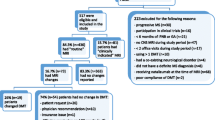Abstract
Serial magnetic resonance imaging (MRI) detects substantial subclinical disease activity in multiple sclerosis (MS) and is presently included in most treatment trials as an objective outcome measure. Our current knowledge of the role of MRI in MS treatment trials is derived from very limited patient studies, and the aim of this paper is to identify strategies to optimize the use of MRI in monitoring disease activity in treatment trials. The number of active lesions revealed by MRI can be used as the primary outcome measure in exploratory treatment trials. With monthly scanning, the majority of active lesions will be seen by virtue of a limited number of new areas of gadolinium enhancement. The contrast between enhancing lesions and background could be increased by: (1) using higher doses of gadolinium, (2) suppressing the background signal with magnetization transfer, (3) delayed scanning, or (4) a combination of these. Following a systematic comparison of those approaches, the effect on the sensitivity in detecting active lesions should be analysed with reference to the power of treatment trials. We present preliminary results showing marked agreement between observers in reporting enhancing lesions; however, with new acquisition strategies, the observer variation should be re-established in a multicentre fashion. In definitive trials, the increase in total lesion load serves as a secondary outcome measure. Since the majority of lesions making up the total lesion load are inactive during the study, spatial resolution should be maximized in order to preclude any artificial changes in lesion load to be superimposed (noise) upon the relatively small actual change (information). Reduction in measurement error can be attempted by improved acquisition techniques with increased lesion to background contrast. More importantly, improvement in quantitation techniques is warranted. With a 6% coefficient of variation in measuring a baseline lesion load, we calculate the standard error of the mean yearly increase in T2 lesion load (typically 10% in untreated patients) in a treatment arm of 124 patients to be 7.5%. A comparison of several quantitation techniques should be performed in a multicentre longitudinal fashion in order to include variation caused by both scanner and segmentation technique, in addition to biological activity.
Similar content being viewed by others
Author information
Authors and Affiliations
Additional information
Received: 29 January 1996 Received in revised form: 15 July 1996 Accepted: 5 August 1996
Rights and permissions
About this article
Cite this article
Barkhof, F., Filippi, M., Miller, D. et al. Strategies for optimizing MRI techniques aimed at monitoring disease activity in multiple sclerosis treatment trials. J Neurol 244, 76–84 (1997). https://doi.org/10.1007/s004150050053
Issue Date:
DOI: https://doi.org/10.1007/s004150050053




